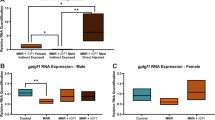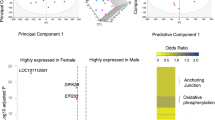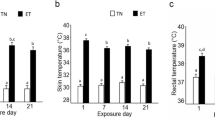Abstract
Background
Fetal responses to adverse pregnancy environments are sex-specific. In fetal guinea pigs (GPs), we assessed morphology and messenger RNA (mRNA) expression in fetal growth-restricted (FGR) tissues at midpregnancy.
Methods
Female GPs were assigned either an ad libitum diet (C) or 30% restricted diet (R) prior to pregnancy to midpregnancy. At midpregnancy, a subset of R females underwent ultrasound-guided nanoparticle (NP) injection to enhance placental function. Five days later, fetuses were sampled. Fetal brain, heart, and liver were assessed for morphology (hematoxylin and eosin), proliferation (Ki67), and vascularization (CD31), as well as expression of inflammatory markers.
Results
R fetuses were 19% lighter with reduced organ weights and evidence of brain sparing compared to controls. No increased necrosis, proliferation, or vascularization was found between C and R nor male or female fetal organs. Sexual dimorphism in mRNA expression of Tgfβ and Ctgf was observed in R but not C fetal brains: increased expression in females. NP treatment increased fetal brain mRNA expression of Tgfβ and Ctgf in R males, abolishing the significant difference observed in untreated R fetuses.
Conclusions
Sex-specific differences in mRNA expression in the fetal brain with FGR could impart a potential survival bias and may be useful for the development of treatments for obstetric diseases.
Impact
-
Male and female fetuses respond differently to adverse pregnancy environments.
-
Under fetal growth restriction conditions, inflammatory marker mRNA expression in the fetal brain was higher in females compared to males.
-
Differences in gene expression between males and females may confer a selective advantage/disadvantage under adverse conditions.
-
Better characterization of sexual dimorphism in fetal development will aid better development of treatments for obstetric diseases.
Similar content being viewed by others
Log in or create a free account to read this content
Gain free access to this article, as well as selected content from this journal and more on nature.com
or
References
Resnik, R. & Lockwood, C. Fetal growth restriction: Evaluation and management. UpToDate, Waltham, MA (Accessed Oct. 20, 2016). (2013).
Greene, M. F. et al. Creasy and Resnik’s Maternal-Fetal Medicine: Principles and Practice E-Book (Elsevier Health Sciences, 2008).
Baschat, A. A. & Hecher, K. Fetal growth restriction due to placental disease. Semin. Perinatol. 28, 67–80 (2004).
Roberts, C. T. IFPA Award in Placentology Lecture: complicated interactions between genes and the environment in placentation, pregnancy outcome and long term health. Placenta 31, S47–S53 (2010).
Vatten, L. J. & Skjaerven, R. Offspring sex and pregnancy outcome by length of gestation. Early Hum. Dev. 76, 47–54 (2004).
Aiken, C. E. & Ozanne, S. E. Sex differences in developmental programming models. Reproduction 145, R1–R13 (2013).
Rickard, I. J., Russell, A. F. & Lummaa, V. Producing sons reduces lifetime reproductive success of subsequent offspring in pre-industrial Finns. Proc. Biol. Sci. 274, 2981–2988 (2007).
Mathews, F., Johnson, P. J. & Neil, A. You are what your mother eats: evidence for maternal preconception diet influencing foetal sex in humans. Proc. Biol. Sci. 275, 1661–1668 (2008).
Vickers, M. H., Clayton, Z. E., Yap, C. & Sloboda, D. M. Maternal fructose intake during pregnancy and lactation alters placental growth and leads to sex-specific changes in fetal and neonatal endocrine function. Endocrinology 152, 1378–1387 (2011).
Wilcoxon, J. S., Schwartz, J., Aird, F. & Redei, E. E. Sexually dimorphic effects of maternal alcohol intake and adrenalectomy on left ventricular hypertrophy in rat offspring. Am. J. Physiol. Endocrinol. Metab. 285, E31–E39 (2003).
Clifton, V. L. Review: Sex and the human placenta: mediating differential strategies of fetal growth and survival. Placenta 31, S33–S39 (2010).
Lumey, L. H. & Stein, A. D. Offspring birth weights after maternal intrauterine undernutrition: a comparison within sibships. Am. J. Epidemiol. 146, 810–819 (1997).
Sohlstrom, A. et al. Food restriction alters pregnancy-associated changes in IGF and IGFBP in the guinea pig. Am. J. Physiol. 274, E410–E416 (1998).
Kind, K. L. et al. Chronic maternal feed restriction impairs growth but increases adiposity of the fetal guinea pig. Am. J. Physiol. Regul. Integr. Comp. Physiol. 288, R119–R126 (2005).
Elias, A. A., Ghaly, A., Matushewski, B., Regnault, T. R. & Richardson, B. S. Maternal nutrient restriction in guinea pigs as an animal model for inducing fetal growth restriction. Reprod. Sci. 23, 219–227 (2016).
Wilson, R., Lampe, K., Matushewski, B. J., Regnault, T. R. & Jones H. N. Time mating guinea pigs by monitoring changes to the vaginal membrane throughout the estrus cycle and with ultrasound confirmation. bioRxiv https://doi.org/10.1101/2020.08.21.256255 (2020).
Wilson, R. L. et al. Nanoparticle mediated increased insulin-like growth factor 1 expression enhances human placenta syncytium function. Placenta 93, 1–7 (2020).
Abd Ellah, N. et al. Development of non-viral, trophoblast-specific gene delivery for placental therapy. PLoS ONE 10, e0140879 (2015).
Depreux, F. F., Czech, L. & Whitlon, D. S. Sex genotyping of archival fixed and immunolabeled guinea pig cochleas. Sci. Rep. 8, 5156 (2018).
Wilson R. L. et al. Insulin-like growth factor 1 signaling in the placenta requires endothelial nitric oxide synthase to support trophoblast function and normal fetal growth. bioRxiv https://doi.org/10.1101/2020.08.21.261420 (2020).
Hiersch, L. & Melamed, N. Fetal growth velocity and body proportion in the assessment of growth. Am. J. Obstet. Gynecol. 218, S700–S711.e701 (2018).
Swanson, A. M. et al. The use of ultrasound to assess fetal growth in a guinea pig model of fetal growth restriction. Lab Anim. 51, 181–190 (2017).
Cahill, L. S., Zhou, Y. Q., Seed, M., Macgowan, C. K. & Sled, J. G. Brain sparing in fetal mice: BOLD MRI and Doppler ultrasound show blood redistribution during hypoxia. J. Cereb. Blood Flow Metab. 34, 1082–1088 (2014).
Morrison, S., Gardner, D. S., Fletcher, A. J., Bloomfield, M. R. & Giussani, D. A. Enhanced nitric oxide activity offsets peripheral vasoconstriction during acute hypoxaemia via chemoreflex and adrenomedullary actions in the sheep fetus. J. Physiol. 547, 283–291 (2003).
Li, Y., Gonzalez, P. & Zhang, L. Fetal stress and programming of hypoxic/ischemic-sensitive phenotype in the neonatal brain: mechanisms and possible interventions. Prog. Neurobiol. 98, 145–165 (2012).
Elias, A. A. et al. Maternal nutrient restriction in guinea pigs leads to fetal growth restriction with evidence for chronic hypoxia. Pediatr. Res. 82, 141–147 (2017).
Reynolds, C. M., Vickers, M. H., Harrison, C. J., Segovia, S. A. & Gray C. Maternal high fat and/or salt consumption induces sex-specific inflammatory and nutrient transport in the rat placenta. Physiol. Rep. 3, e12399 (2015).
Gabory, A. et al. Maternal diets trigger sex-specific divergent trajectories of gene expression and epigenetic systems in mouse placenta. PLoS ONE 7, e47986 (2012).
Evans, L. & Myatt, L. Sexual dimorphism in the effect of maternal obesity on antioxidant defense mechanisms in the human placenta. Placenta 51, 64–69 (2017).
Acknowledgements
We would like to thank Dr. Timothy Regnault at the University of Western Ontario for his assistance with designing the inflammatory cytokine oligonucleotide primer sequences as well as the staff at Vet Services, Cincinnati Children’s Hospital and Medical Center for their assistance with the animal procedures. This study was funded by Eunice Kennedy Shriver National Institute of Child Health and Human Development (NICHD) award R01HD090657 (H.N.J.).
Author information
Authors and Affiliations
Contributions
R.L.W. conceived the study, performed experiments, analyzed the data, and wrote the manuscript. K.K.S. conceived the study, performed experiments, analyzed the data, and wrote the manuscript. K.L. performed experiments and edited the manuscript. H.N.J. conceived the study, obtained the funding, and edited the manuscript. All authors approved the final version.
Corresponding author
Ethics declarations
Competing interests
The authors declare no competing interests.
Additional information
Publisher’s note Springer Nature remains neutral with regard to jurisdictional claims in published maps and institutional affiliations.
Supplementary information
Rights and permissions
About this article
Cite this article
Wilson, R.L., Stephens, K.K., Lampe, K. et al. Sexual dimorphisms in brain gene expression in the growth-restricted guinea pig can be modulated with intra-placental therapy. Pediatr Res 89, 1673–1680 (2021). https://doi.org/10.1038/s41390-021-01362-4
Received:
Revised:
Accepted:
Published:
Issue date:
DOI: https://doi.org/10.1038/s41390-021-01362-4
This article is cited by
-
Placental nanoparticle-mediated IGF1 gene therapy corrects fetal growth restriction in a guinea pig model
Gene Therapy (2025)
-
Mid-Pregnancy Placental Transcriptome in a Model of Placental Insufficiency with and without Novel Intervention
Reproductive Sciences (2025)
-
Maternal Gene Delivery for the Prevention and Treatment of Obstetric Conditions
Current Stem Cell Reports (2024)
-
Maternal Uterine Artery Adenoviral Vascular Endothelial Growth Factor (Ad.VEGF-A165) Gene Therapy Normalises Fetal Brain Growth and Microglial Activation in Nutrient Restricted Pregnant Guinea Pigs
Reproductive Sciences (2024)
-
A Low Dose of Ouabain Alters the Metabolic Profile of Adult Rats Experiencing Intrauterine Growth Restriction in a Sex-Specific Manner
Reproductive Sciences (2023)



